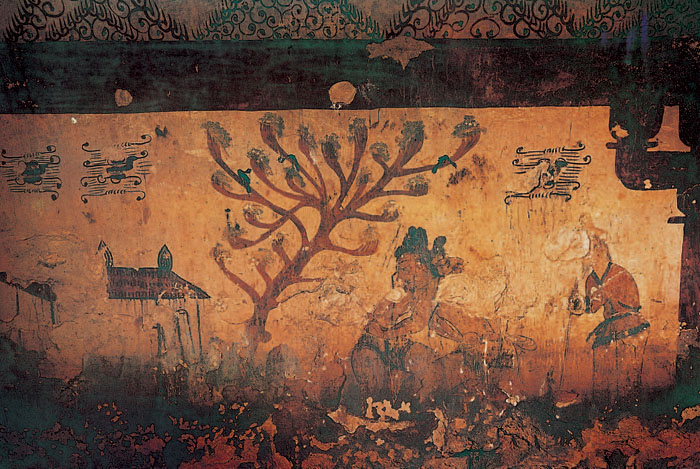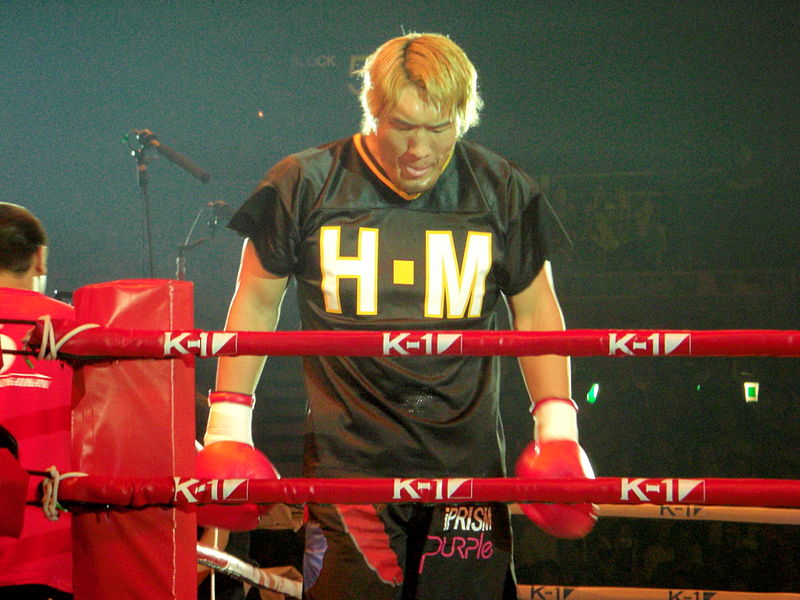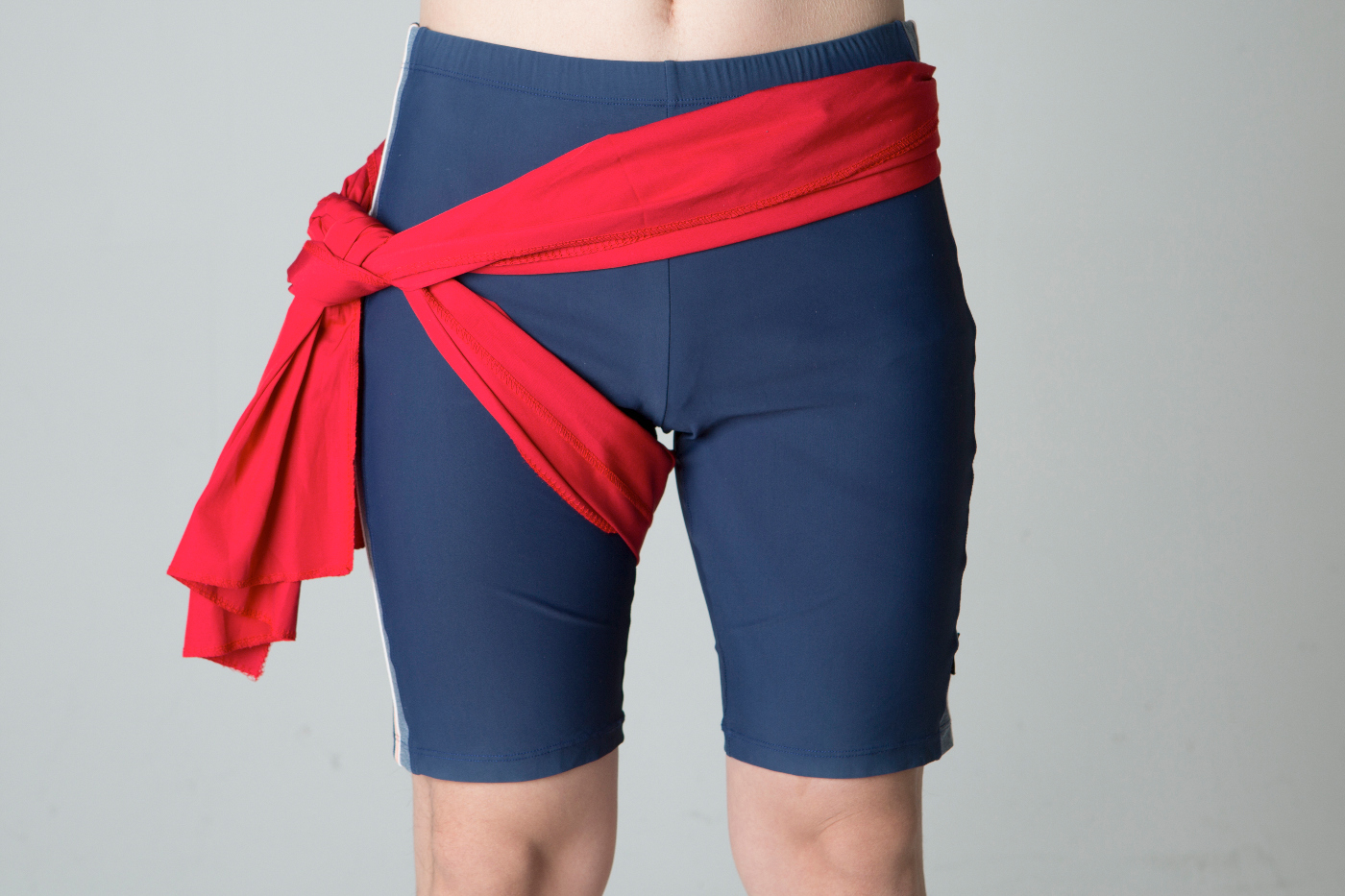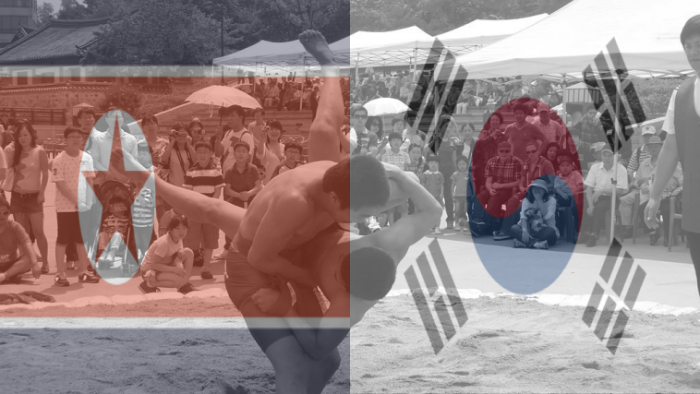Table of Contents
Intro
The latest article in our series on Asian wrestling is dedicated to Ssireum – a Korean traditional wrestling style with millennia of history, that is now again turning into a major spectator sport, revered in both the North and the South.
In recent years there’s been peaking interest in Korean culture. This phenomenon has been dubbed the “K wave”, and the craze caused by TV show Squid game has only been one of its latest manifestations.
As worldwide curiosity for the Korean ways increases, there might soon be a suitable environment for other Korean sports to follow in Taekwondo and Hapkido’s footsteps to fame.
So join us in discovering an exciting form of belt wrestling by taking a closer look at its past and present, the rules that govern its competitions and the techniques it employs.
1. Origins of Ssireum & place in Korean culture
When did Korean wrestling appear?
Ssireum (씨름) is believed to be among the oldest forms of sport practiced in Korea. But just how old is it? That is a difficult question to answer.
Though some sources claim 5000 years of history, what is sure is that Korean wrestling was practiced at least since the times of the Three Kingdoms.
You see, it turns out multiple Korean states coexisting is nothing new. From 57 BC to 668 AD three main kingdoms existed on the peninsula – Goguryeo, Baekje, and Silla. It’s the wall murals inside a Goguryeo tomb that are some of the earliest evidence of Ssireum’s existence.

Why did Ssireum start to be practiced?
Like most martial arts, Ssireum is thought to have originated as a form of self defense but very early on it made the leap to becoming a sport – as Koreans would point out, you can very clearly see the presence of a referee depicted in the tomb mural.
Becoming an integral part of Korean culture
Korean wrestling appears in texts of the subsequent Goryeo period, and according to the wonderfully summarised history of Ssireum on KSA’s page, at the time it became a favourite pastime for all – from kings to peasants.
Later, at the time of the Joseon Dynasty, Ssireum matches continued to be portrayed in a vivid graphic way.

Wrestling has become a part of the broader traditions of Koreans, and competitions are organized on the major national holidays: Daeborum, Dano and Chuseok.
The spoils of victory – what’s the champion’s prize?
As Korea was an agrarian society at the time Ssireum appeared, the traditional prize for the winner was an ox or bull – something that would be very valuable to every farmer. However, although ancient, Korean wrestling has proven to also be very dynamic in its evolution – in more recent days (from the 70s onwards) many events decorate their champs with lavish cash prizes.
Many names
Korean wrestling’s attitude towards change has also been reflected in its name (and it’s uniform – but more on that later…). The name Ssireum was adopted in the 20th century, before that Gakjeo, Baekhui, and Gakgi were used. According to the Encyclopedia of Korean folk culture, all these names can be roughly translated to ‘to faceoff’/’to confront’/’to compare each other’s strength’.
2. Ssireum today
From ancient times to present day Korean wrestling has mostly enjoyed stable popularity. The Korea Ssireum Research Institute at Yeungnam University has assembled a timeline-like list of historical evidence of Ssireum’s presence throughout the ages.
From traditional custom to modern sport venue
During the second half of the 20th century Ssireum reached the point in its development where division between amateurs and professionals started to happen. This came naturally as big events with lots of stiff competition (because of the prizes) weren’t suitable for all.
Of course, bigger tournaments and the fact that Ssireum was among the first sports to be televised in Korea, further boosted its popularity. Except for the Koreans’ love for their grappling style there was one more factor at play that made all this possible. Corporate sponsorship – at the time, many of the major corporations had teams that represented them. It was great publicity.
Headwinds of the 2000s
And it was all good until a financial crisis hit East Asia in 1997. According to some sources, the following crunch in sponsorship money was a heavy blow on Ssireum, and practically caused a dip in its popularity that it has been trying to recover from ever since.
While that is reasonable, we believe that there is another underlying factor behind Ssireum’s recent struggles – the K-pop culture. Weird as it may sound there seems to be a connection between the two, and the key to understanding it is just as unlikely – weight classes.
Again thanks to the The Korea Ssireum Research Institute we found out that weigh classes were first introduced in the 12th National Ssireum Championship Contest. The system was simple: a division over 71.3kg and a division below 71.3kg – that’s it. In 1967 the rules changed and five different divisions were added only to be simplified to three divisions in 1975. But the point is that the top weight class had always been open-ended, and the heavyweights were always the ones getting the most attention. And as we know, open-ended divisions tend to almost force most athletes in them to become as heavy as they can be, which in turn leaves them looking less than athletic and alters the whole perception of the sport.
“Rebranding” & comeback
Having the image of a sport that favors overweight people put Ssireum in a bad spot at a time when most Koreans aspired to the slim figures of K-pop idols.
Federations and governing bodies have taken notice, and to try and regain favour, are now putting top limits on the heaviest weight classes, while supplementing their actions with a strong media campaign. Some major media have referred to this as ‘an attempt to rebrand’ Korean wrestling.
2.1 Celebrities practicing Ssireum
Probably the Ssireum champion who is most famous outside of Korea is actually better known for his victories in another sport altogether.

Yes, the K-1 kickboxing star actually started his martial arts career as a Ssireum wrestler. He reached the peak of his wrestling career in 2003, winning the open division of 42nd edition of the Korean Ssireum Championships.
Another notable Korean celebrity that has won that tournament (a total of 5 times to be exact) is Ho-dong Kang who later became a famous television host and comedian.
With Ssireum regaining the public’s interest, many people are eager to try their hand at it – like UFC fighter Dong Hyun ‘Stun Gun’ Kim, who although not a Ssireum wrestler, did participate in an exhibition match on Korean national TV.
2.2 Ssireum in North Korea
The whole picture
After all the talk about the dynamics of Ssireum’s popularity over the years, it’s appropriate to clarify that we had been looking at South Korea the whole time. Its way more secretive neighbor to the North however is also a bearer of this grappling style’s heritage and has been preserving and developing it as well.
Obviously, after over 70 years of division there are some differences in how Ssireum is practiced in both states, but we’ll leave this comparison for later when we look at the rules of the sport.
All evidence seems to suggest that Ssireum is as dear to the hearts of North Koreans as it is to their southern counterparts – they have also kept organizing competitions on some of their most important traditional holidays like Dano and Chuseok.
Coming together for the right cause
So, in an act of historic importance, both Koreas made a joint application to UNESCO for the inclusion of Ssireum in the List of Intangible Cultural Heritage of Humanity. This was unprecedented, and shows that common traditions may be a path towards national reconciliation.
3. The rules of Ssireum
Ssireum: a multi-faceted subject
Korean wrestling is a mature sport, so as a consequence many rulesets exist. For example, professional Ssireum is considered a different thing, that’s separate from scholastic and collegiate amateur Ssireum. And that’s without factoring-in forms in the DPRK.
So as you can already see, this is a hard topic to summarize, and doing a comprehensive review of it would likely require its own article.
Settling for oversimplification
Since the differences are generally in subtleties, like weight classes, scoring, match duration, etc., we decided to keep things simple and only go over what’s worth mentioning. As base for this discussion, we’ll be using the Korea Ssireum Association’s (KSA) ruleset.
3.1 What constitutes a victory in Ssireum?
Similarly to Naga wrestling (which is a belt wrestling style we’ve covered earlier), Ssireum matches are contested in 3 rounds, with only pro tournament finals going 5 rounds. To be victorious, you have to win 2 out of 3 rounds (or 3 out of 5, respectively, for finals).
Winning matches – a round by round approach
So how do you win a round? Simply make your opponent touch the ground with one of their knees or with any part of their body above the knee. And as you will soon see from the techniques section of this article, Ssireum’s rules are much more liberal in the means they provide you to reach this goal than almost any other style of belt wrestling.
“Let’s call it a draw?”
There is no such thing as a draw in Ssireum. If time runs out with both wrestlers scoring an equal amount of rounds, an additional 30 second round is declared. If that passes with no one scoring, and the two competitors have received the same number of warnings, then the one who is lighter is declared winner. This is something that really resonates with the current concept of putting the spotlight on the learner athletes.
3.2 Garments (uniforms) & gripping rules
The Ssireum uniform
The Ssireum competition uniform consists of two elements:
- A pair shorts; and
- A belt, made of cotton cloth, called the Satba.
On the outer left part of the shorts is the competitor’s identification – his name and the name of the organisation he represents. The shorts may not be gripped.
It’s important to mention that in North Korea, in addition to their version of the shorts, wrestlers also wear a sleeveless jacket top that somewhat resembles the Shuai Jiao uniform but as with the shorts is also not used for grips.
Satba – the Ssireum belt


However the belt or Satba is by far the more important part of the uniform. It’s used for gripping and the way it’s tied around the waist and thigh is unique to Ssireum, and not seen in any other wrestling style around the world. It gives wrestlers a very special kind of leverage, being asymmetric, and makes off-balancing easier thereby making the whole match more dynamic as it is harder to stall than in other belt wrestling styles.
As Ssireum’s Wikipedia page will tell you, there used to be two ways of tying the Satba: a “right-sided” and a “left-side” style, each favored in different provinces. As Korean wrestling further developed as a sport, standardising the way to tie the belt became necessary, and the left-sided style was adopted as the official style.
If you were ever wondering how to tie a Satba, the folks at KSA made helpful video:
The Satba – not as old as it looks
Now, the Satba might seem like something ancient but it’s actually an example of Ssireum’s lack of hesitation when it comes to innovating. As it turns out, Ssireum wasn’t always a belt wrestling style – the Satba belt was added in the 1920s, and before that competitors wrestled with their pants rolled-up, (the resulting fabric was gripped).
Gripping rules
And speaking of grips, unlike most belt wrestling styles, Ssireum does allow switching and readjusting grips after the match has started (however you’re not allowed to break the opponent’s grip). The condition is to only let go with one hand at a time, and keep the other on the opponent’s Satba. This rule enables leg grabs which form a very interesting part of Korean wrestling’s arsenal.
3.3 Other general competition rules
Competition area
In addition to the Satba belt, the other thing that immediately grabs the attention of someone witnessing a Ssireum match for the first time is the arena on which it is contested.
It’s called a Ssireum-Jang, and consists of a sand pit with a diameter of 8 to 10 meter and a 1.5 meter auxiliary or safety area. The pit is filled with 10 to 20 centimetres of natural silica sand.
The competition area is actually one of the main differences in how Ssireum is practiced in the North and the South – the DPRK’s wrestlers actually don’t compete on Jangs and use mats instead.
Start of the match
A match starts with both wrestlers taking identical grips on each other’s Satba, under close supervision from the referee, and then waiting for his signal.
The very process of this grip setting is quite characteristic of Ssireum. It involves the two contestants first kneeling on the sand in front of each other and taking grips (always first at the thigh, and then at the waist). Then, getting up by imperatively raising the left knee first. And finally, remaining in a position of shoulder-to-shoulder contact (without any bending at the arms), while waiting for the start signal.

In South Korea there is even a name for this mini-ritual (baro-japki), but in the North the custom is to take grips while standing.
Match duration
As already mentioned, under KSA rules, a Ssireum match consists of 3 rounds (or 5, for pro tournament finals). Each round is 1 minute in duration, and there is a minute of rest time in-between rounds.
Weight classes
For pro’s
We’ve glanced upon the subject of weight classes earlier. In professional Ssireum there are traditionally 4 weight classes named after the tallest peaks in Korea. These are:
- Taebaek, up to 75 kg;
- Geumgang, up to 90 kg;
- Halla, up to 105 kg; and
- Baekdu, under 140 kg (till 2018 used to be up to 160 kg).
And for amateurs
For the collegiate and Semi-pro competitions, organized by the KSA, the following weight classes are used:
- Gyeongjanggeub up to 75 ㎏;
- Sojanggeub up to 80 ㎏;
- Cheongjanggeub up to 85;
- Yongjanggeub up to 90 ㎏;
- Yongsageub up to 95 ㎏;
- Yeokskgeup up to 105 ㎏; and
- Jangsageub up to 140 kg.
4. Techniques
Extremely well-rounded takedowns
Korean wrestling’s collection of techniques is rich indeed. To demonstrate just how complete it’s takedown game is, we’ll compare it to Judo.
As we all know Judo is a very systemized martial art, and it classifies throws in the following major groups:
- hand throwing techniques (includes leg grabs);
- hip throwing techniques;
- foot/leg throwing techniques; and
- sacrifice techniques.
Well, Ssireum has all of those.
The list of Ssireum techniques
How do we know? As it turns out, the KSA made a catalogue of the most used takedowns in Ssireum, together with their names, descriptions in English, and even real neat little illustrations so you can visualize better. You can find it all here.
No ground game
What Ssireum doesn’t have is a ground game. Due to the fact that upon touching the ground with anything above the knee the round is lost (or you get restarted, if it happened outside bounds), pinning techniques are simply not used.
And as for submissions, disqualification is the only thing you can earn attempting one.
5. Ssireum vs. Sumo
It may be because of the geographical proximity or the way the arenas look similar, but many foreigners mistakenly refer to Ssireum as ‘Korean Sumo’.
In fact, both styles evolved separately and there are some key differences between them. Let’s take a closer look:
- Sumo (相撲, Sumō) is one the most popular traditional wrestling styles in the world, and originates from Japan.
- Perhaps the easiest to spot difference between it and Ssireum is that unlike the former’s Satba belt, sumo wrestlers wear a loincloth, made out of silk that is called Mawashi.
- Moreover, in Sumo there is no grip setting in the beginning of the match, before the referee’s signal. And, in contrast to Ssireum, you are allowed to break the opponent’s grips.
- While the sumo arena appears to resemble a Ssireum-Jang it’s not the same. The dohyō, as it is called, may be of circular shape as well, but is made of rice-straw bales that are buried in clay.
- As for the techniques of the two styles – they do allow almost the same moves, with the exception of Sumo’s slaps (harite), that would get you instant DQ in Korean wrestling.
- You score much the same way in both sports, but In Ssireum you can’t win a round by pushing the opponent out of bounds – that’ll just get you restarted.
- Speaking of rounds – a Sumo match is one round of 4 minutes.
- And finally – the first thing that people notice about Sumo wrestlers is their size. It attracts bigger athletes (and they have motivation to grow even more) because professional Sumo has no weight classes. To the contrary, Korean wrestling does have weight classes, and the heaviest has recently been capped at 140 kg.
Conclusion
So there you have it – we just got a glimpse of a traditional wrestling style with ancient roots, that nevertheless has been flexible enough so as to overcome many threats to its popularity over the ages.
Hopefully the comeback it’s staging turns out successful, as it has a lot to offer as a spectator sport.
And as of gaining world-wide popularity – even though the International Ssireum Association has members in 12 countries outside the Koreas, for now the process seems slow, even considering that Korean communities around the world also have their initiatives to popularize Ssireum.
But as we’ve seen with Korean wrestling’s current revival in its homeland, nowadays one video going viral is enough to turn the trend around.

